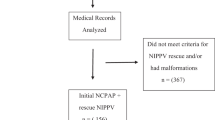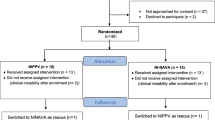Abstract
Respiratory distress syndrome (RDS) is the most common respiratory morbidity in preterm infants. Surfactant therapy and invasive mechanical ventilation through the endotracheal tube (ETT) have been the cornerstones in RDS management. Despite improvements in the provision of mechanical ventilation, bronchopulmonary dysplasia (BPD), a multifactorial disease in which invasive mechanical ventilation is a known contributory factor, remains an important cause of morbidity among preterm infants. Barotrauma, volutrauma or oxygen-induced lung inflammation (oxy-trauma) contributes significantly to the development of BPD in neonates ventilated through an ETT. Recently, nasal respiratory support has been increasingly used in preterm infants in an attempt to decrease post-extubation failure and, perhaps, BPD, and for the treatment of apnea of prematurity in nonventilated neonates. Observational studies using noninvasive respiratory support, such as nasal continuous positive airway pressure (NCPAP), have shown a decrease in the incidence of BPD when used to avoid intubation or minimize the duration of invasive mechanical ventilation through the ETT. Moreover, synchronized as well as nonsynchronized nasal intermittent positive-pressure ventilation (NIPPV) have been shown to significantly decrease post-extubation failure compared with NCPAP and their use has been associated with a reduced risk of BPD in small randomized controlled clinical trials. More recently, early surfactant administration followed by extubation to NIPPV has been suggested to be synergistic in decreasing BPD. Although these findings are promising, additional studies evaluating different nasal interfaces, flow synchronization, synchronization using neurally adjusted ventilatory assist mode, and closed loop control of oxygen during nasal ventilation to minimize lung injury are needed in an attempt to further decrease the incidence of lung injury in preterm neonates requiring respiratory support.
This is a preview of subscription content, access via your institution
Access options
Subscribe to this journal
Receive 12 print issues and online access
$259.00 per year
only $21.58 per issue
Buy this article
- Purchase on Springer Link
- Instant access to full article PDF
Prices may be subject to local taxes which are calculated during checkout

Similar content being viewed by others
References
Walsh MC, Yao Q, Gettner P, Hale E, Collins M, Hensman A et al. Impact of a physiologic definition of bronchopulmonary dysplasia rates. Pediatrics 2004; 114: 1305–1311.
Crowley P, Chalmers I, Keirse MJNC . The effects of corticosteroid administration before preterm delivery: a review of the evidence from controlled trials. Br J Obstet Gynaecol 1990; 97: 11–25.
Soll RF . Prophylactic natural surfactant extract for preventing morbidity and mortality in preterm infants. Cochrane Database Syst Rev 2000 Issue 2. Art. no.: CD000511.
Jobe AH, Bancalari E . Bronchopulmonary dysplasia. NICHD-NHLBI-ORD Workshop. Am J Respir Crit Care Med 2001; 163: 1723–1729.
Watterberg KL, Demers LM, Scott SM, Murphy S . Chorioamnionitis and early lung inflammation in infants in whom bronchopulmonary dysplasia develops. Pediatrics 1996; 97: 210–215.
Groneck P, Gotze-Speer B, Oppermann M, Eiffert H, Speer CP . Association of pulmonary inflammation and increased microvascular permeability during the development of bronchopulmonary dysplasia: a sequential analysis of inflammatory mediators in respiratory fluids of high-risk preterm neonates. Pediatrics 1994; 93: 712–718.
Gonzalez A, Sosenko IRS, Chandar J, Hummler H, Claure N, Bancalari E . Influence of infection on patent ductus arteriosus and bronchopulmonary dysplasia in premature infants <1000 g. J Pediatr 1996; 128: 470–478.
Choi CW, Kim BI, Kim H, Park JD, Choi J, Son DW . Increase of interleukin-6 in tracheal aspirate at birth: a predictor of subsequent bronchopulmonary dysplasia in preterm infants. Acta Pediatr 2006; 95: 38–43.
Bollen CW, Uiterwaal CS, van Vught AJ . Cumulative metaanalysis of high-frequency versus conventional ventilation in premature neonates. Am J Respir Crit Care Med 2003; 168: 1150–1155.
Gregory GA, Kitterman JA, Phibbs RH, Tooley WH, Hamilton WK . Treatment of idiopathic respiratory distress syndrome with continuous airway pressure. N Engl J Med 1971; 284 (24): 1333–1340.
Sahni R, Ammari A, Suri MS, Milisavljevic V, Ohira-Kist K, Wung JT et al. Is the new definition of bronchopulmonary dysplasia more useful? J Perinatol 2005; 25: 41–46.
Kahn DJ, Habib RH, Courtney SE . Effects of flow amplitude on intraprong pressures during bubble versus ventilator-generated nasal continuous positive airway pressure in premature infants. Pediatrics 2008; 122 (5): 1009–1013.
Stefanescu BM, Murphy WP, Hansell BJ, Fuloria M, Morgan TM, Aschner JL . A randomized, controlled trial comparing two different continuous positive airway pressure systems for the successful extubation of extremely low birth weight infants. Pediatrics 2003; 112: 1031–1038.
Locke RG, Wolfson MR, Shaffer TH, Rubenstein SD, Greenspan JS . Inadvertent administration of positive end-distending pressure during nasal cannula flow. Pediatrics 1993; 91: 135–138.
Chang GY, Cox CC, Shaffer TH . Nasal cannula, CPAP and vapotherm: effect of flow on temperature, humidity, pressure and resistance. Pediatr Acad Soc 2005; 57: 1231.
Sreenan C, Lemke RP, Hudson-Mason A, Osiovich H . High-flow nasal cannulae in the management of apnea of prematurity: a comparison with conventional nasal continuous positive airway pressure. Pediatrics 2001; 107: 1081–1083.
Frey B, Shann F . Oxygen administration in infants. Arch Dis Child Fetal Neonatal Ed 2003; 88: F84–F88.
Davis P, Davies M, Faber B . A randomised controlled trial of two methods of delivering nasal continuous positive airway pressure after extubation to infants weighing less than 1000 g: binasal (Hudson) versus single nasal prongs. Arch Dis Child Fetal Neonatal Ed 2001; 85: F82–F85.
Robertson NJ, McCarthy LS, Hamilton PA, Moss AL . Nasal deformities resulting from flow driver continuous positive airway pressure. Arch Dis Child Fetal Neonatal Ed 1996; 75: F209–F212.
Ridout R, Townsend S, Kelley P, Rosenberg AA, Parker TA . Nasal septal necrosis resulting from nasal synchronized intermittent mandatory ventilation in VLBW infants. Pediatr Res 2002; 51: 348A/2025.
Avery ME, Tooley WH, Keller JB, Hurd SS, Bryan MH, Cotton RB et al. Is chronic lung disease in low birth weight infants preventable? A survey of eight centers. Pediatrics 1987; 79: 26–30.
Van Marter LJ, Allred EN, Pagano M, Sanocka U, Parad R, Moore M et al. Do clinical markers of barotrauma and oxygen toxicity explain interhospital variation in rates of chronic lung disease? The Neonatology Committee for the Developmental Network. Pediatrics 2000; 105: 1194–1201.
Subramaniam P, Henderson-Smart DJ, Davis PG . Prophylactic nasal continuous positive airways pressure for preventing morbidity and mortality in very preterm infants. Cochrane Database Syst Rev 2005Issue 3. Art. no.: CD001243.
Stevens TP, Blennow M, Myers EH, Soll R . Early surfactant administration with brief ventilation vs selective surfactant and continued mechanical ventilation for preterm infants with or at risk for respiratory distress syndrome. Cochrane Database Syst Rev 2007 Issue 4. Art. no.: CD003063.
Morley CJ, Davis PG, Doyle LW, Brion LP, Hascoet JM, Carlin JB et al. Nasal CPAP or intubation at birth. N Engl J Med 2008; 358: 700–708.
Buettiker V, Hug MI, Baenziger O, Meyer C, Frey B . Advantages and disadvantages of different nasal CPAP systems in newborns. Intensive Care Med 2004; 30: 926–930.
Kiciman NM, Andréasson B, Bernstein G, Mannino FL, Rich W, Henderson C et al. Thoracoabdominal motion in newborns during ventilation delivered by endotracheal tube or nasal prongs. Pediatr Pulmonol 1998; 25: 175–181.
Moretti C, Gizzi C, Papoff P, Lampariello S, Capoferri M, Calcagnini G et al. Comparing the effects of nasal synchronized intermittent positive pressure ventilation (nSIPPV) and nasal continuous positive airway pressure (nCPAP) after extubation in very low birth weight infants. Early Human Development 1999; 56: 166–177.
Aghai ZH, Saslow JG, Nakhla T, Milcarek B, Hart J, Lawrysh-Plunkett R et al. Synchronized nasal intermittent positive pressure ventilation (SNIPPV) decreases work of breathing (WOB) in premature infants with respiratory distress syndrome (RDS) compared to nasal continuous positive airway pressure (NCPAP). Pediatr Pulmonol 2006; 41: 875–881.
Garland JS, Nelson DB, Rice T, Neu J . Increased risk of gastrointestinal perforations in neonates mechanically ventilated with either face mask or nasal prongs. Pediatrics 1985; 76: 406–410.
Friedlich P, Lecart C, Posen R, Ramicone E, Chan L, Ramanathan R . A randomized trial of nasopharyngeal-synchronized intermittent mandatory ventilation versus nasopharyngeal continuous positive airway pressure in very low birth weight infants after extubation. J Perinatol 1999; 19: 413–418.
Barrington KJ, Bull D, Finer NN . Randomized trial of nasal synchronized intermittent mandatory ventilation compared with continuous positive airway pressure after extubation of very low birth weight infants. Pediatrics 2001; 107: 638–641.
Khalaf MN, Brodsky N, Hurley J, Bhandari V . A prospective randomized, trial comparing synchronized nasal intermittent positive pressure ventilation versus nasal continuous positive pressure as modes of extubation. Pediatrics 2001; 108: 13–17.
Kugelman A, Feferkorn I, Riskin A, Chistyakov I, Kaufman B, Bader D . Nasal intermittent mandatory ventilation versus nasal continuous positive airway pressure for respiratory distress syndrome: a randomized, controlled, prospective study. J Pediatr 2007; 150: 521–526.
Moretti C, Giannini L, Fassi C, Gizzi C, Papoff P, Colarizi P . Nasal flow-synchronized intermittent positive pressure ventilation to facilitate weaning in very low-birthweight infants: unmasked randomized controlled trial. Pediatrics International 2008; 50 (1): 85–91.
Bhandari V, Gavino RG, Nedrelow JH, Pallela P, Salvador A, Ehrenkranz RA et al. A randomized controlled trial of synchronized nasal intermittent positive pressure ventilation in RDS. J Perinatol 2007; 27: 697–703.
Ramanathan R, Sekar KC, Rasmussen M, Bhatia J, Soll RF . Nasal intermittent positive pressure ventilation (NIPPV) versus synchronized intermittent mandatory ventilation (SIMV) after surfactant treatment for respiratory distress syndrome (RDS) in preterm infants <30 weeks gestation: multicenter, randomized, clinical trial. Late-Breaker Abstract. Pediatrics 2009 A3212.6.
Bhandari V, Finer NN, Ehrenkranz RA, Saha S, Das A, Walsh MC et al. Synchronized nasal intermittent positive-pressure ventilation and neonatal outcomes. Pediatrics 2009; 124: 517–526.
Ramanathan R, Andaya S, Sardesai S, Cayabyab R, Garingo A, Seri I . Nasal respiratory support (NARES) in preterm infants: a novel means of delivering pressure and flow limited (PFL) IMV via nasal cannula (NC-IMV). Acta Pediatrica 2009; 98: s460, A1174.
Author information
Authors and Affiliations
Corresponding author
Ethics declarations
Competing interests
Rangasamy Ramanathan was a consultant for Dey, LP.
Additional information
This paper resulted from the Evidence vs. Experience in Neonatal Practices Conference, 19 to 20 June 2009, sponsored by Dey LP.
Rights and permissions
About this article
Cite this article
Ramanathan, R. Nasal respiratory support through the nares: its time has come. J Perinatol 30 (Suppl 1), S67–S72 (2010). https://doi.org/10.1038/jp.2010.99
Published:
Issue Date:
DOI: https://doi.org/10.1038/jp.2010.99
Keywords
This article is cited by
-
RAM cannula with Cannulaide versus Hudson prongs for delivery of nasal continuous positive airway pressure in preterm infants: an RCT
Scientific Reports (2021)
-
Comparative bench study evaluation of different infant interfaces for non-invasive ventilation
BMC Pulmonary Medicine (2018)
-
Non-invasive ventilation and surfactant treatment as the primary mode of respiratory support in surfactant-deficient newborn piglets
Pediatric Research (2018)
-
Neonatal nasal intermittent positive pressure ventilation efficacy and lung pressure transmission
Journal of Perinatology (2015)
-
Nasal intermittent positive pressure ventilation versus nasal continuous positive airway pressure in neonates: A systematic review and meta-analysis
Indian Pediatrics (2013)



